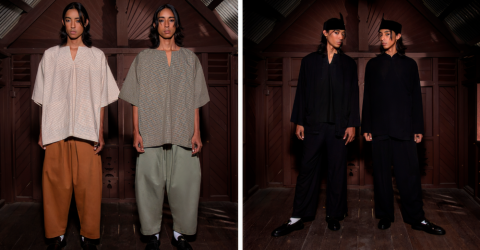KELVIN Tan Khai Wen, publicly known as Kel Wen, has always been one who does not shy away from risks. As the man behind Behati, the 30-year-old Muar designer has made a name for himself with his fashion-forward interpretations of traditional wear.
From his 2019’s Raya collection of oversized baju melayu to Datuk Seri Vida’s telekung dress at 2023’s Astro Most Gempak Awards, Wen has breathed new life into Malaysia’s cultural styles.
This Raya, he explores tradition further with his interpretations of kebaya in his Qaba collection. Inspired by the etymology of kebaya, the collection makes a bold move to introduce it as menswear, presenting a masculine influence to the traditionally female piece.
What prompted your interest in kebaya?
This collection’s name is Qaba and it is a tribute to kebaya. I wanted to pay homage because kebaya is a Nusantara fashion icon, originating from Indonesia and Arab (states).
It started off as Qaba from the Arabs and then it evolved into kebaya, as we know it today. So, this collection details the transformation from Qaba to kebaya. That said, I wanted it to also have a Malaysian aspect to it. Since multiracialism is one of the biggest points of Malaysian traditional wear, I wanted it to show that this kebaya is made in Malaysia – you cannot get (this) anywhere else.
Take, for instance, the Kebaya Baba in our collection, which pays tribute to our local Peranakan culture. It is more minimal and it fits a man’s body. Normally, it is only made for women. But I have created a shirt-inspired, corporate and modern kebaya. To me, this is what Malaysian tradition is about. It is always about trying to innovate things.
Do you think your exploration of kebaya will invite criticism?
My purpose for having Qaba as the title is to celebrate kebaya. I really want people to learn about the history of the word and piece.
For those wondering why I am making kebaya for men, I am hoping to prove kebaya is not only for women. My purpose is to only expand the market. This is just the first step. Hopefully, we can all have more variations of traditional wear in the future to showcase our Malaysian identity.
Why did you decide to play with darker colours this time around?
There is a lot happening in the world right now. Hence, the world’s mood has been quite dark. So, I wanted this campaign to convey hope through the darkness. You can say this is a metaphor for me trying to remind people to be fearless and not allow our inner demons to control us in this holy month.
This is the first time I have touched horror in my art because I am not a fan of horror films. I am actually scared of horror films. But, I enjoyed this as a new experience. To me, it is about fighting my personal fears. And, to be able to create something out of it is a positive message. So, that is what I hope to convey.
Could you elaborate on some of the materials you utilised?
Songket is the main material I used because I do not see enough songket items. So in this collection, I wanted to present more design variations on how to wear one. For instance, I made a reversible sampin and a baju melayu with it. Normally, people would only use a songket for sampin but it is such a nice fabric. I would want to wear it as a top.
Also, we would only wear sampin with baju melayu. But these days, we want something easy. When I am attending a Raya event, sometimes I prefer not to dress too full with a sampin covering but I love songket.
How do I solve this issue then? I just make it into a top and I can wear my jeans. The idea is to appreciate the culture, but also make it easy to style with. That is my goal – to create new styles using traditional methods and fabric.
How would you say the songket contributes to the overall feel and aesthetic?
Although it is dark, it is very rich at the same time, which is what songket is to me. For me, songket has never been happy or joyful. Instead, I have always seen it as dark and sophisticated.
This is especially true with the songket I picked this time around. It has a black base with hints of metallic gold and silver, just to represent the golden and silver age that we are having at this point.
It is to showcase time in a way. This is because I feel it is the most classic and I want to achieve a new classic. For this collection, I hope to build this image of a traditional songket. When people think of songket, I hope they think of gold, silver and bronze, which are the best colours in my opinion.
Any specific piece you are particularly fond of?
Other than the songket, we do also have kain pelikat this season. I love kain pelikat because it is very casual. You can style it with jeans. You can dress it down or up. It all depends on how you style it. It also has that cultural element, which I love. This is because kain pelikat is originally from India. So, there is that cultural exchange.
What was the hardest aspect about bringing this collection to life?
The biggest challenge was the timeline for this year. The time frame between Chinese New Year and Raya was short. I am still trying to get used to it. This whole collection actually came out in a month. Although I only showcased 20 designs, I actually had 80 designs. So, that was the biggest challenge – to make it in time and to conceptualise everything.
Will we be seeing you at KL Fashion Week this year?
Yes, you will. You can expect similar vibes as with this collection. It is still going to be dark but it is going to be a fun one. I have been planning it.








